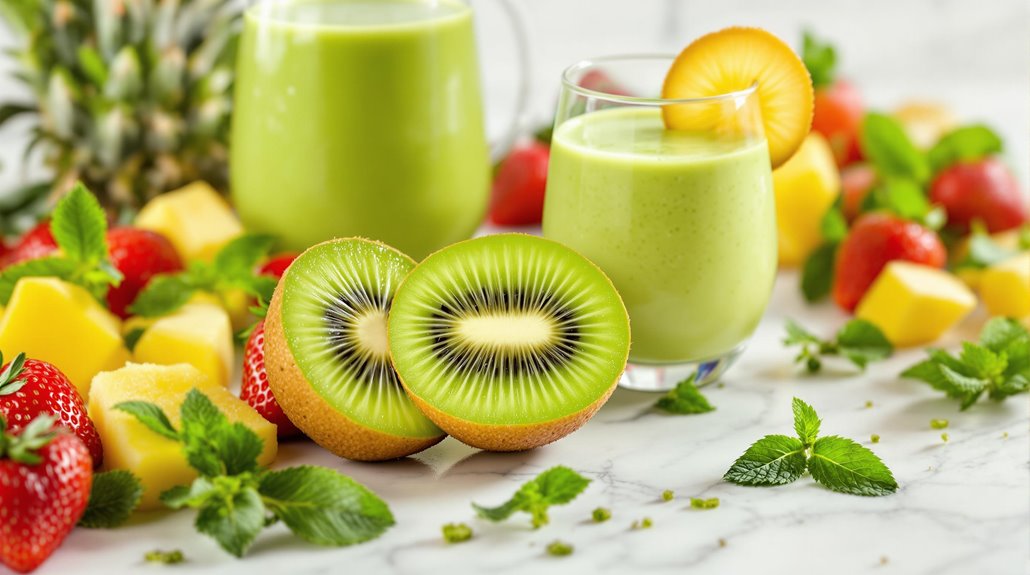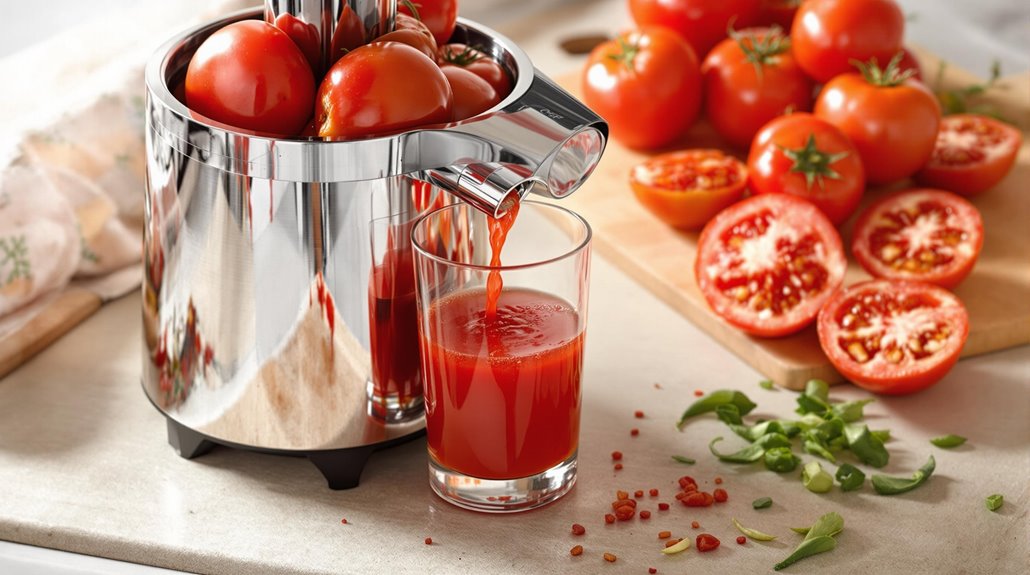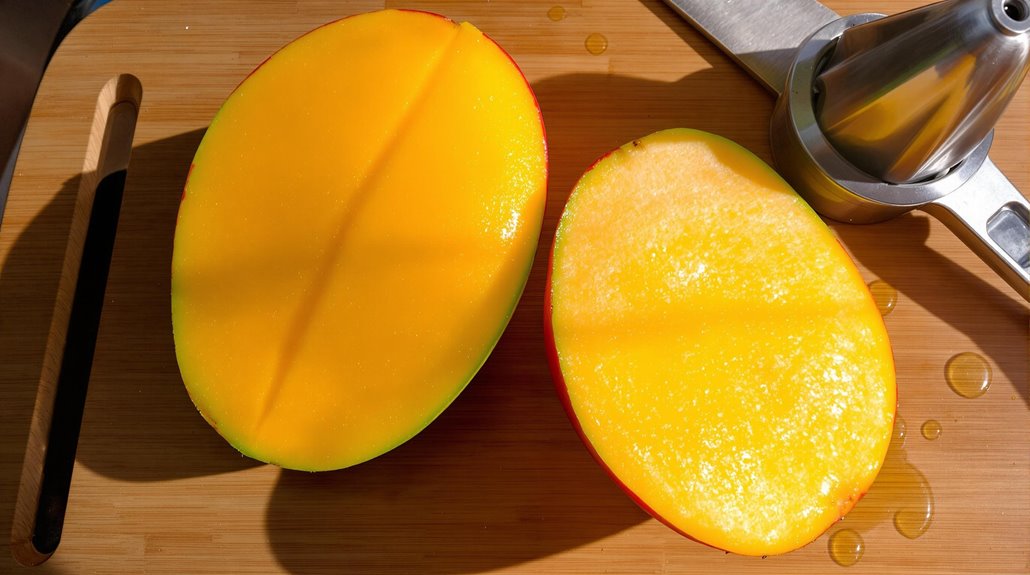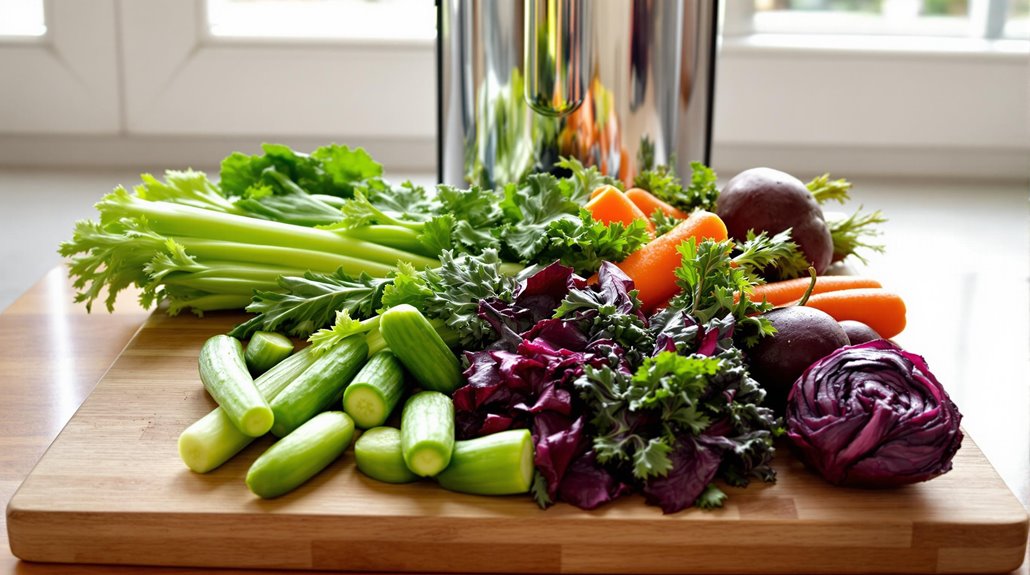Do You Peel a Kiwi for Juicing?
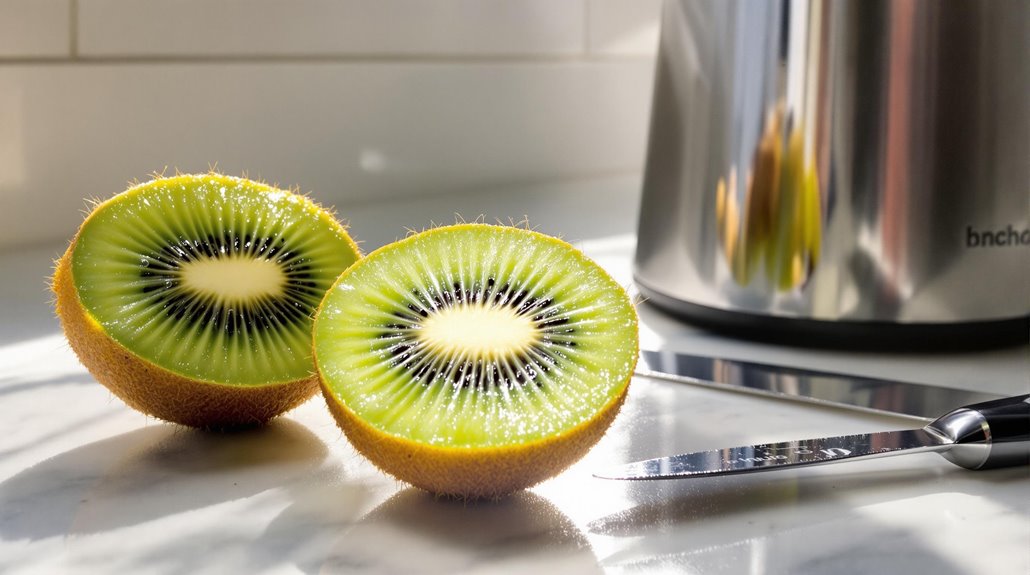
You don't need to peel kiwis before juicing them. In fact, keeping the skin on provides up to three times more antioxidants and vitamin C compared to using just the flesh. While unpeeled kiwis create a slightly thicker juice with a touch of tartness, the skin is completely safe to consume and makes the juicing process more efficient. If you're focused on maximizing nutrition and saving prep time, the unpeeled method offers convincing/persuasive/potent advantages worth exploring.
The Great Kiwi Peel Debate
Whether to peel or not to peel kiwis for juicing sparks an ongoing debate among health enthusiasts and home juicers alike. When you're making kiwi fruit juice, keeping the skin on offers significant nutritional advantages, including higher levels of vitamin C and other essential nutrients found in the peels.
You'll find that leaving the skin on creates a more streamlined process, as kiwi peels won't clog your juicer. The skin's presence also enhances the overall nutritional profile of your juice without compromising the juicing experience. However, if you're particular about texture and flavor, you might prefer removing the skin using a peeler, knife, or spoon for a smoother, pulp-free result. Like natural energy drinks, kiwi juice provides a healthy boost of vitamins and minerals that can increase your energy levels naturally. Ultimately, your choice to keep or discard the peel comes down to personal preference, balancing nutritional benefits against your desired juice consistency.
Nutritional Benefits of Kiwi Skin
The nutritional powerhouse hiding in kiwi skin might make you think twice about peeling your fruit before juicing. When you discard the peel, you're missing out on up to three times more antioxidants and vitamin C compared to the flesh alone. The fuzzy exterior is completely edible and packs an impressive nutritional punch.
You'll get 50% more fiber from the skin than the flesh, helping support your digestive health. The peel is also rich in flavonoids, which offer anti-inflammatory and anti-cancer benefits. By keeping the skin on during juicing, you'll enhance your intake of essential nutrients, including 50% more folate and 30% more potassium. These compelling benefits make a strong case for leaving the skin intact when you're preparing your kiwi for juicing. Similar to other nutritious juices, kiwi with skin can help maintain healthy blood circulation and support cardiovascular health.
Taste Differences: Peeled Vs Unpeeled
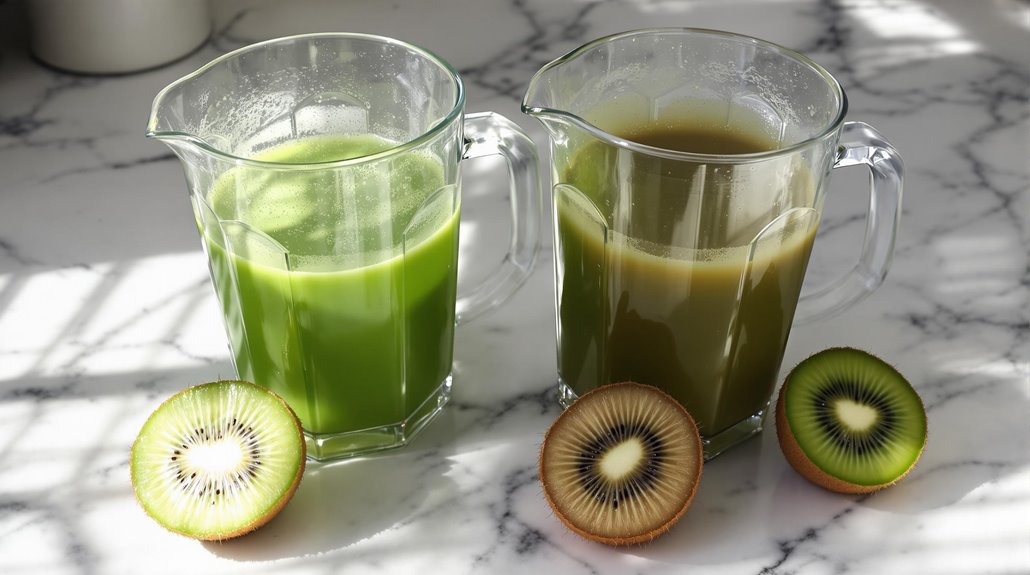
Striking differences emerge when comparing the taste profiles of peeled versus unpeeled kiwi juice. The peel can add a slightly bitter or tart note to your juice, while removing it results in a sweeter, more balanced flavor.
You'll also notice distinct variations in texture - leaving the peel on creates a thicker, pulpier consistency that some may find less appealing than the smoother texture of peeled kiwi juice.
When deciding whether to peel your kiwi, consider these key factors:
- Taste preference between sweet or slightly bitter flavors
- Desired consistency - smooth versus pulpy texture
- Nutritional goals, as the peel contains 328 times more antioxidants
- Time investment in preparation and washing
Remember that whichever method you choose, thoroughly washing your kiwi is critical to guarantee safe consumption.
Similar to how soluble fiber aids in maintaining healthy arteries, kiwi's fiber content provides valuable digestive benefits.
Best Practices for Juicing Kiwi
Successful kiwi juicing depends largely on proper preparation and technique. You'll want to select ripe kiwi that's slightly soft to the touch, as these will produce the most juice while delivering prime nutrients. Before starting the juicing process, thoroughly wash your kiwi to remove any pesticide residue, especially if you're using non-organic fruit.
When making kiwi juice, you can leave the skin on to maximize your intake of antioxidants and fiber. The seeds are also perfectly safe to include, adding both texture and nutritional value to your drink. For the most efficient approach, simply cut the clean kiwi into chunks and blend or juice it with the skin intact. This streamlined method not only saves time but guarantees you're getting the full range of nutrients from every part of the fruit.
Cleaning and Preparing Your Kiwis
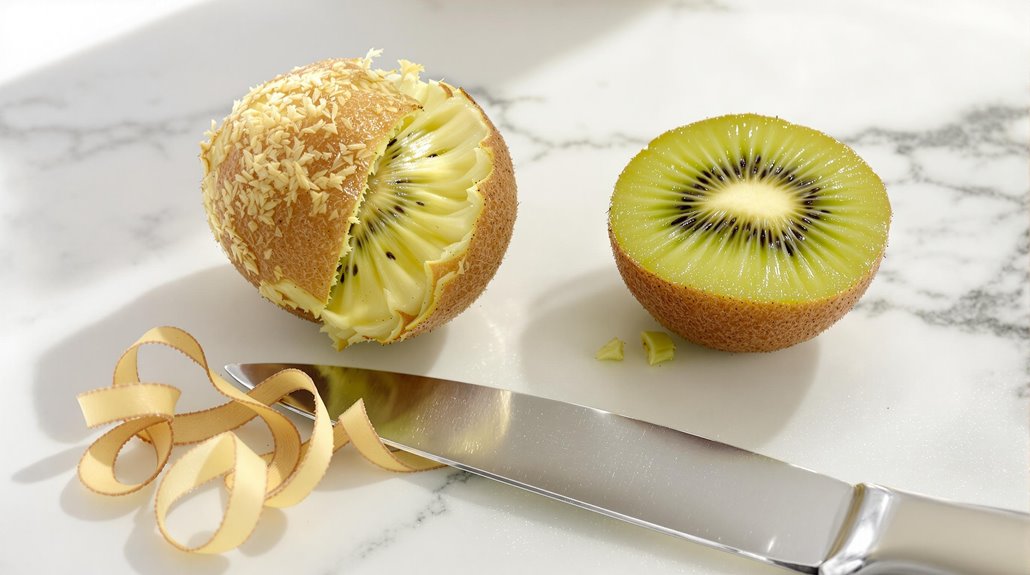
Properly cleaning and preparing your kiwis before juicing guarantees both safety and maximum flavor extraction. You'll want to wash thoroughly and clean kiwis using a scrub brush to remove dirt and any residue on the surface.
Before moving forward with the juicing process, slice top bottom ends off to prepare kiwis for easier processing.
- Use an abrasive sponge or scrub brush to clean the exterior thoroughly
- Cut off both ends of the kiwi for easier handling
- Decide whether to keep or remove the skin (it's completely optional)
- Choose your preferred method: juicer, blender, or food processor
Once you've completed these steps, you're ready to juice your kiwis. If you find the thick pulpy consistency too intense, you can add water to achieve your desired texture.
Impact on Juicing Equipment
When it comes to juicing equipment, kiwi skin won't cause any mechanical problems or damage to your machine. Unlike tougher fruits like pineapple, kiwi peels are soft and thin enough to process easily through your juicer. In fact, leaving the skin on can help make your juicing process more efficient.
The skin's simple texture actually aids in pushing other ingredients through the machine while making kiwi juice. You'll find that the peels work similarly to other soft fruits, moving smoothly through the equipment without causing clogs or strain. When you're juicing kiwis with their skin on, you don't need to worry about your machine struggling or getting damaged. This makes kiwis one of the more forgiving fruits to juice, allowing you to focus on creating delicious and nutritious beverages without equipment concerns.
Storage and Shelf Life Considerations
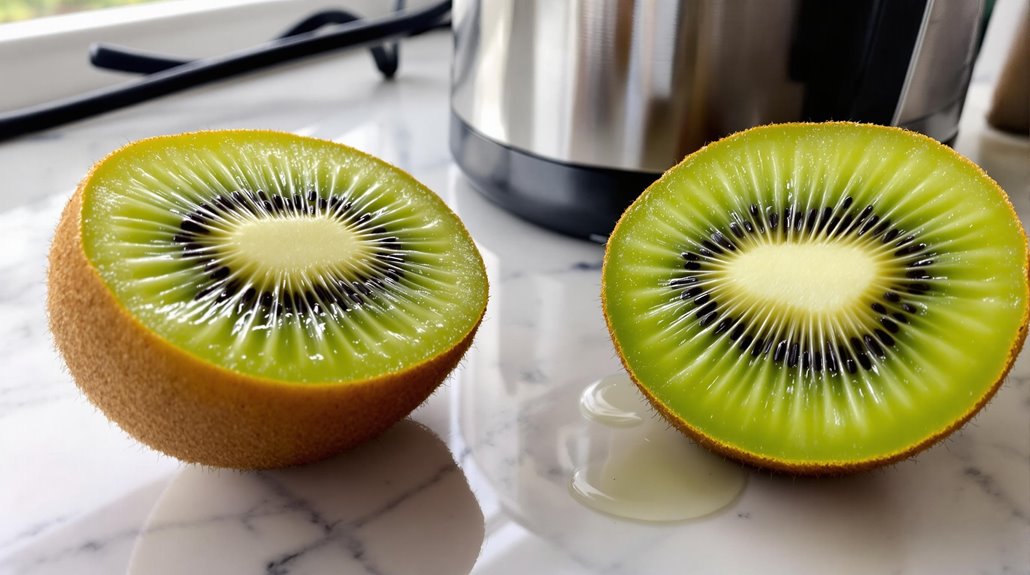
The storage timeline for kiwi juice plays an essential role in maintaining its quality and nutritional value. For the best fresh flavor and nutritional benefits, you'll want to consume your fresh juice within 24 hours of preparation.
If you have leftover kiwi juice, you can keep it refrigerated for up to three days, though you might notice some separation or thickening over time.
- Always stir your stored juice before drinking to redistribute any settled ingredients
- Keep juice in an airtight container to preserve its bright green color
- Freeze juice in ice cubes for extended shelf life and convenient portions
- Use frozen kiwi juice cubes within 3 months for ideal taste
Remember to monitor your stored juice for any changes in appearance or smell, as these can indicate it's time to make a fresh batch.
Health Considerations and Allergies
Beyond storing your kiwi juice safely, understanding potential health impacts and allergies can affect your decision to peel or not peel. If you're not allergic to kiwi skin, keeping it on provides extra vitamins, antioxidants, and fiber that you'll miss with removal. However, you'll need to thoroughly wash the fruit to reduce pesticide residues on the surface.
If you have known allergies to kiwi skin proteins, it's crucial to peel the fruit before juicing to prevent potential reactions. Similarly, if you experience digestive issues, removing the skin can help minimize irritation. Keep in mind that including the skin will create a thicker juice with more pulp, which some people may find less appealing. Consider your personal health needs and preferences when deciding whether to peel.
Popular Kiwi Juice Combinations
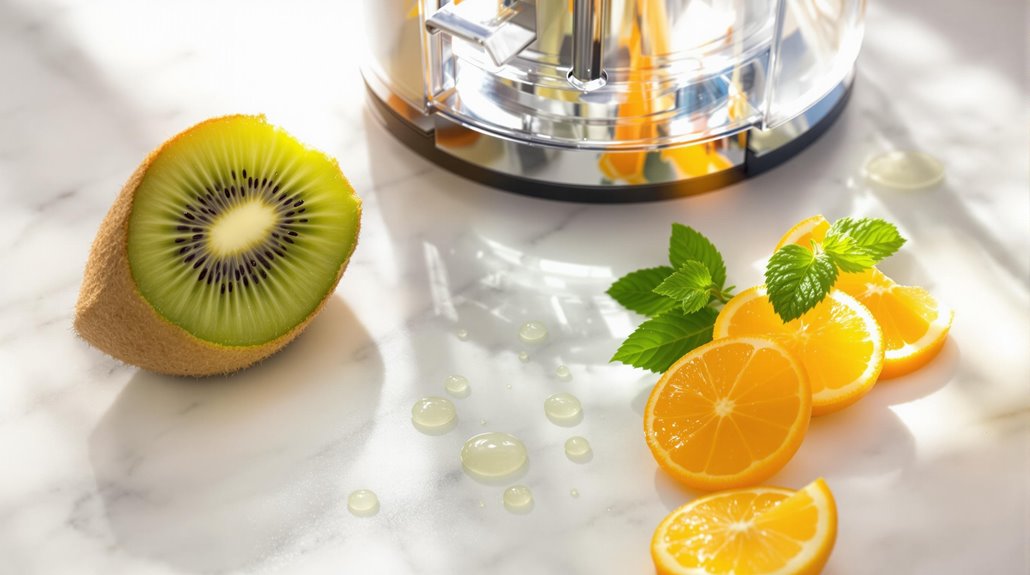
Mixing kiwi juice with complementary fruits and ingredients creates exciting flavor combinations while maximizing nutritional benefits. You'll find that fresh kiwi juice pairs wonderfully with various ingredients to provide considerably higher amounts of vitamins and minerals. Feel free to experiment with these proven combinations to enhance your health benefits.
- Blend kiwi with orange or lime to create a citrus-forward drink that's perfectly balanced between sweet and tart
- Add spinach or kale to your juice without even noticing a marked change in taste
- Mix with tropical fruits like mango for an extra burst of vitamin-rich refreshment
- Combine with watermelon or cucumber to create a hydrating beverage that's perfect after exercise
For additional nutrients, you can remove the peels or add chia seeds to elevate your juice's nutritional profile.
Time and Cost Efficiency Tips
Making kiwi juice doesn't have to strain your wallet or schedule when you follow smart preparation strategies. The Art of Efficient Peeling starts with selecting kiwis that are just soft enough to fit your juicer's feed chute. To streamline your juicing process, cut kiwis into quarters rather than spending extra time on precise peeling.
Use a fine mesh strainer to prevent soft pulp obstructing your juicer, saving time and effort on cleanup. Efficient Peeling with Simple Tips includes batch preparation - process multiple kiwis at once and store them properly. You'll optimize the preparation process by keeping your tools ready and workspace organized.
Consider buying kiwis in bulk when they're on sale, and freeze portions for future use to maximize cost efficiency.

